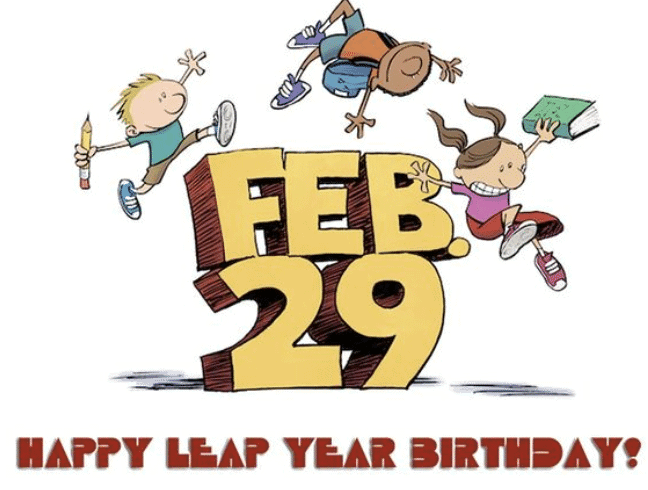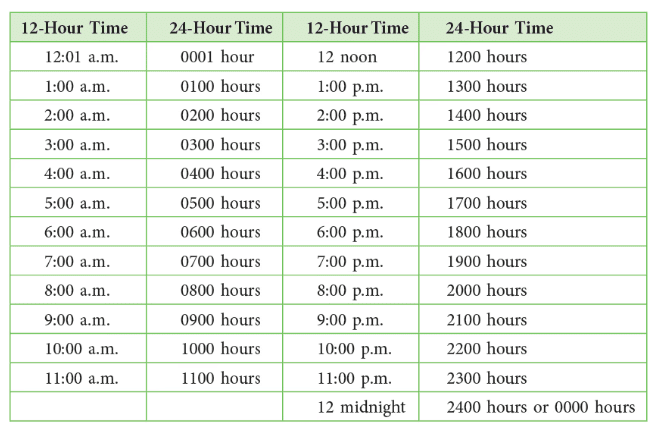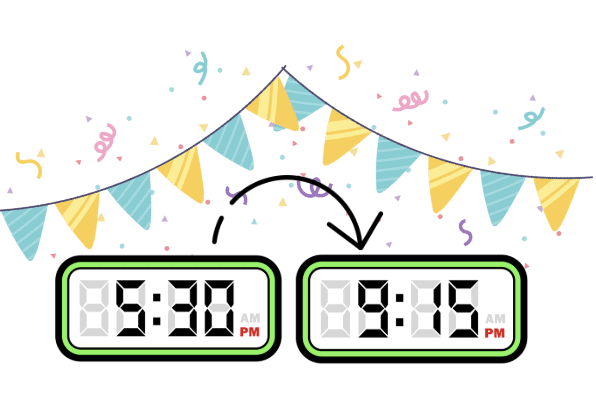Class 4 Maths Word Problems Chapter 12 Ticking Clocks and Turning Calendar
Q1: Shania was born on 29th February 2016. He wants to celebrate his birthday every year, but the date only appears in leap years. How many times has his real birthday come up between 2016 and 2025?
Sol: Leap years occur every 4 years: 2016, 2020, 2024
Between 2016 and 2025, Parv had birthdays on:
2016, 2020, and 2024 → 3 times
Q2: Naina's mom baked a cake on 25th February 2024. The expiry date on the cake is 5th March 2024. For how many days will the cake be fresh?
Sol: We need to count how many days the cake stays fresh from 25th February to 5th March.
Let's count each day:
25th Feb (the day it was baked)
26th Feb
27th Feb
28th Feb
29th Feb (2024 is a leap year, so February has 29 days)
1st March
2nd March
3rd March
4th March
5th March (expiry date)
Now let’s count them:
1 (25th) + 1 (26th) + 1 (27th) + 1 (28th) + 1 (29th) + 1 (1st Mar) + 1 (2nd) + 1 (3rd) + 1 (4th) + 1 (5th) = 10 days
Q3: Raunak sees a clock showing 03:45. His sister says it’s morning (a.m.), but he thinks it’s evening (p.m.). How can he write both times using the 24-hour clock format?
Sol: Clocks can show time in two ways:
12-hour clock (with a.m. and p.m.)
24-hour clock (used by railways, airports, etc.)

Now,
03:45 in the morning (a.m.) stays the same in 24-hour time → 0345 hours
But for 03:45 in the evening (p.m.), we must add 12 hours to convert it to 24-hour time:
3 + 12 = 15 → so 03:45 p.m. = 1545 hours
Q4: Charu leaves at 2:20 p.m. to pick up the cake and returns home at 3:05 p.m. How many minutes did he take for the round trip?
Sol: Charu left at 2:20 p.m. and came back at 3:05 p.m.
To find out how long he was out, we subtract 2:20 from 3:05.
Let’s break it down:
From 2:20 to 2:30 = 10 minutes
From 2:30 to 3:00 = 30 minutes
From 3:00 to 3:05 = 5 minutes
Now, add the minutes together:
10 + 30 + 5 = 45 minutes
Q5: Urvi watched a cartoon from 6:45 p.m. to 7:30 p.m. After a 10-minute break, he watched another show for 25 minutes. What time did he finish watching TV?
Sol: First show: 6:45 – 7:30 (45 min)
Break: 10 min → 7:30 – 7:40
Second show: 25 min → 7:40 – 8:05
→ 8:05 p.m.
Q6: Sanjana’s birthday party started at 5:30 p.m. and ended at 9:15 p.m. How long did the party last?
Sol: From 5:30 to 9:15
→ 5:30–6:30 = 1 hr
→6:30 to 7:30 = 1 hr
→ 7:30 to 8:30 = 1 hr
→8:30 to 9:15 = 45 mins
Total = 3 hours 45 minutes
Q7: Ishveena blew up 1 balloon every 5 minutes. If he started at 4:00 p.m. and ended at 5:00 p.m., how many balloons did he blow?
Sol: We are told that Parv blew 1 balloon every 5 minutes, and he worked from 4:00 p.m. to 5:00 p.m.
Let’s find out how much total time he spent blowing balloons:
From 4:00 to 5:00 = 60 minutes
Now, since each balloon takes 5 minutes, we divide 60 by 5:
60 ÷ 5 = 12
Q8: Anmol's school celebrates annual day on the last Friday of March. If 31st March 2023 is a Friday, what date was the annual day that year?
Sol: We are told that 31st March 2023 is a Friday.
That means 31st March was the last Friday of March in 2023, because it is the last day of the month and it’s also a Friday.
Last Friday of March 2023 = 31st March 2023
Q9: Pooja's toy time machine jumped 3 years ahead and 7 months back. If today is 6 May 2025, what date did it travel to?
Sol: Step 1: Move 3 years ahead from 6 May 2025
→ 6 May 2025 + 3 years = 6 May 2028
Step 2: Now go 7 months back from 6 May 2028
Let’s count backward:
April 2028
March 2028
February 2028
January 2028
December 2027
November 2027
October 2027
So, after going 7 months back, we land on 6 October 2027
Q10: Parv wants to convert 2 years and 3 months into just months. How many months is that?
Sol: We know that:
 So, 2 years = 2 × 12 = 24 months
So, 2 years = 2 × 12 = 24 months
Now, add the extra 3 months:
24 + 3 = 27 months
|
54 videos|186 docs|14 tests
|
FAQs on Class 4 Maths Word Problems Chapter 12 Ticking Clocks and Turning Calendar
| 1. What are some common types of word problems related to clocks and calendars that Class 4 students might encounter? |  |
| 2. How can students effectively solve word problems involving time and calendars? |  |
| 3. Why is it important for Class 4 students to learn about time and calendars? |  |
| 4. What strategies can teachers use to make learning about clocks and calendars engaging for students? |  |
| 5. How can parents assist their Class 4 children in understanding word problems related to time and calendars? |  |





















